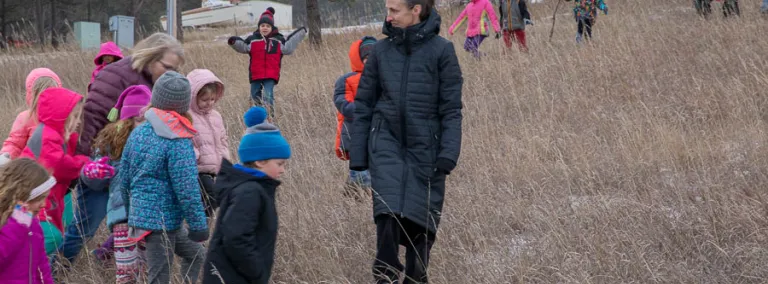Excited about science
Education team develops programming to augment science instruction in South Dakota
“Look over here!”
“I found some evidence!”
“Deer, deer!”
The excited shouts came from kindergartners in Kara Schroeder’s class as they searched for evidence of animals in a field near their playground at Corral Drive Elementary School in Rapid City.
“They had so much fun,” Shroeder said. “We’ve had lots of great learning on the word, ‘scat.’”
Schroeder is one of dozens of teachers across South Dakota who are using curriculum units that were developed by the Education and Outreach (E&O) team at Sanford Lab. Schroeder recently began using the "Creature Features" curriculum unit, which was developed for K-12 students.
“You know, I didn’t think there would be enough to keep kids engaged. But from the very first class, where we looked at bugs, they were so excited. They just loved every single part of it,” Schroeder said. “I’m planning to do this again and again.”
That’s exactly what the E&O team wants to hear. Since 2015, the team has developed and implemented 10 curriculum units, six assembly programs and several field trip activities. Last week, alone, they reached more than 200 students in South Dakota. And since the program was implemented, that number has reached more than 25,000 students.
“The most important thing we try to do with our curriculum units, assembly programs and field trips, is to change the paradigm from studying settled science to exploring unsettled science questions,” said June Apaza, director of Sanford Lab’s E&O department, which is run through Black Hills State University. “We want students to ask questions because science is about solving real-world problems—we want students to learn that science isn’t just about memorizing facts. It’s about solving problems.”
Kathleen Teeslink teaches Fifth Grade at Corral Drive. So far, she’s incorporated “Exploring the Unseen,” a unit that focuses on using indirect evidence to learn about dark matter, and “May the Force be with You,” which explores magnets and magnetic forces.
“The kits are extremely well organized and the activities are very engaging for teachers and students,” Teeslink said. “The activities facilitate high levels of thinking and problem solving—and fit the state science standards. And it's awesome that the activities connect to Sanford Lab in Lead, South Dakota.”
Each curriculum unit is designed around the science at Sanford Lab and includes everything an educator needs to teach the unit. Additionally, teachers can participate in summer workshops to learn how to incorporate the units into their classes. Teeslink has attended two.
“I’ve also received great support from the Sanford Lab Education team,” she said.
The E&O team continues to work on new programs for K-12 and currently is working on two new curriculum units, including a middle school task program that focuses on energy transfers, said Kari Webb, education specialist. Specifically, students will be asked to figure out how certain elements used in the Deep Underground Neutrino Experiment (DUNE) will be transferred from the surface to the detectors nearly a mile underground. But this unit will be offered almost entirely online.
“We want to use computer simulations but also have an option that allows teachers to include a hands-on investigation,” Webb said. The investigation portion would use materials that are readily accessible, to ensure students and teachers don't incur additional costs.
“We’re at a really exciting time,” Webb added. “We have a set of performance expectations that require students to be front and center. It’s not about memorization now, but the practice of science. When we develop units, we want to help our South Dakota teachers create a learning environment that help students make sense of phenomena or design solutions to a problem.”
And it appears to be working.
“After our second class, I had two feathers and a stick brought to class,” Schroeder said. “The girl who brought in the stick said it looked like deer antlers. She knew it wasn’t a deer antler, of course, but she saw the similarities. That’s exciting. I’m just really looking forward to the rest of this unit.”
